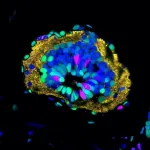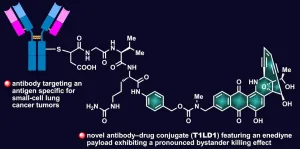Progress in the functional characterization of human olfactory receptors
Odorant receptor OR5K1 is specialized to recognize pyrazines in both humans and domesticated animals
2021-06-22
(Press-News.org) A team of scientists from the Leibniz Institute for Food Systems Biology at the Technical University of Munich has now discovered that the odorant receptor OR5K1 is specialized to recognize pyrazines in both humans and domesticated animals. These are volatile substances that contribute to the typical odor of many vegetables or are formed when food is heated. In addition, pyrazines also play a role as signaling substances in intra- or interspecific communication. The new research results contribute to a better understanding of the molecular mechanisms underlying the odor perception of food as well as olfactory communication.
Olfactory perception is crucial for the recognition and selection of food as well as for the enjoyment when eating. Everyone knows this at the latest when nothing tastes good anymore due to a blocked nose. The perception of odors also influences the behavior of many animals.
For 80 percent, the odor spectrum is unknown
The genes for the receptors with which we perceive odors have been known for over 30 years. However, despite intensive research, the specific odorant spectrum detected by about 80 percent of human olfactory receptors is still unknown.
New findings in this area could help to develop biobased "artificial noses" that can be used, for example, to monitor the sensory quality and authenticity of food. In addition, they could provide insight into the physiological functions of these receptors that go beyond the sensory perception of food.
"In particular, odorants such as pyrazines are interesting in this regard. This is because some of them, as key odorants, shape the typical aroma of food and, at the same time, play a major role as volatile signaling substances in olfactory communication of animals. A good example is wolves, which leave scent messages in their territory via their urine and thus mark it," says team leader Dietmar Krautwurst.
Pyrazine with a dual function
Trimethylpyrazine is one such substance. It is formed during roasting processes, and its scent is reminiscent of baked potatoes, roasted nuts and cocoa. It is therefore a frequently used flavoring agent in the food industry. Likewise, this substance is naturally present in the urine of foxes and wolves and puts mice on alert as soon as they smell it.
However, it was previously unknown which of the human olfactory receptors react to pyrazines. Therefore, the research team used a cellular assay system established at the institute to investigate the responses of over 600 human receptor variants to trimethylpyrazine. As the study results show, the odorant receptor OR5K1 was the only one of the tested variants to react to the substance. A check of the receptor with further odorants showed that it selectively recognizes 18 other pyrazines. For the test, the team used, among other volatiles, 178 key odorants that shape the aroma of food, including some pyrazines.
"Strikingly, those pyrazines, which activate the receptor most potently, function both as food odorants and signaling substances in the animal kingdom," reported Franziska Haag of the Leibniz Institute of Food Systems Biology at the Technical University of Munich, who, together with her former colleague Patrick Marcinek, played a key role in the study. As the study results also showed, corresponding (homologous) olfactory receptors of domestic and farm animals, but also of mice, responded in a similar way to the tested pyrazines as the human receptor. "We therefore assume that the recognition spectrum of the OR5K1 odorant receptor has evolved under the influence of domestication," explains Dietmar Krautwurst. Veronika Somoza, director of the Leibniz Institute adds, "In the future, we will use our unique, extensive odorant and receptor collection at the institute to decipher the function of human olfactory receptors."
INFORMATION:
Publication: Marcinek P, Haag F, Geithe C, Krautwurst D (2021) FASEB J, 35(6):e21638, DOI: 10.1096/fj.202100224R. An evolutionary conserved olfactory receptor for foodborne and semiochemical alkylpyrazines, Open Access, faseb.onlinelibrary.wiley.com/doi/10.1096/fj.202100224R
Expert contact:
PD Dr. Dietmar Krautwurst
Leibniz Institute for Food Systems Biology at the Technical University (Leibniz-LSB@TUM)
Lise-Meitner-Str. 34
85354 Freising, Germany
Phone: +49 8161 71-2634
Email: d.krautwurst.leibniz-lsb@tum.de
Dr. Franziska Haag
Leibniz-LSB@TUM
Phone: +49 8161 71-2716
Email: f.haag.leibniz-lsb@tum.de
Director of Leibniz-LSB@TUM:
Prof. Dr. Veronika Somoza
Email: v.somoza.leibniz-lsb@tum.de
Press contact:
Dr. Gisela Olias
Leibniz-LSB@TUM
Knowledge transfer, press and public relations work
Phone: +49 8161 71-2980
Email: g.olias.leibniz-lsb@tum.de
http://www.leibniz-lsb.de
Information about the Leibniz Institute
The Leibniz Institute for Food Systems Biology at the Technical University of Munich (Leibniz-LSB@TUM) has a unique research profile. Its researchers combine methods of basic biomolecular research with analytical methods of bioinformatics and analytical high-performance technologies. Their goal is to decode the complex ingredient profiles from raw materials to the final food products and to elucidate their function as biological active molecules on humans. Based on their studies, the scientists develop products, which are as healthy as they are tasty. These foods will help to provide a sustainable and sufficient stream of food for future generations. In addition, the new scientific findings will be used to develop personalized nutritional concepts that, for example, help people with food intolerance without compromising quality of life and endangering their health.
The Leibniz LSB@TUM is a member of the Leibniz Association, which connects 96 independent research institutions. Their orientation ranges from the natural sciences, engineering and environmental sciences through economics, spatial and social sciences to the humanities. Leibniz Institutes devote themselves to social, economic and ecological issues. They conduct knowledge-oriented and application-oriented research, also in the overlapping Leibniz research networks, are or maintain scientific infrastructures and offer research-based services. The Leibniz Association focuses on knowledge transfer, especially with the Leibniz Research Museums. It advises and informs politics, science, business and the public. Leibniz institutions maintain close cooperation with universities - among others, in the form of the Leibniz Science Campuses, industry and other partners in Germany and abroad. They are subject to a transparent and independent review process. Due to their national significance, the federal government and the federal states jointly fund the institutes of the Leibniz Association. The Leibniz Institutes employ around 20,000 people, including 10,000 scientists. The entire budget of all the institutes is more than 1.9 billion euros.
+++ Via our Twitter channel https://twitter.com/LeibnizLSB you stay up to date +++
[Attachments] See images for this press release:

ELSE PRESS RELEASES FROM THIS DATE:
2021-06-22
A single measurement result is not a proof - this has been shown again and again in science. We can only really rely on a research result when it has been measured several times, preferably by different research teams, in slightly different ways. In this way, errors can usually be detected sooner or later.
However, a new study by Prof. Andrej Pustogow from the Institute of Solid State Physics at TU Wien together with other international research teams shows that this can sometimes take quite a long time. The investigation of strontium ruthenate, a material that plays an important role in unconventional superconductivity, has now disproved an experiment that gained fame in the 1990s: it was believed that a novel form of superconductivity ...
2021-06-22
The spinal cord is an important component of our central nervous system: it connects the brain with the rest of the body and plays a crucial part in coordinating our sensations with our actions. Falls, violence, disease - various forms of trauma can cause irreversible damage to the spinal cord, leading to paralysis, sometimes even death.
Although many vertebrates, including humans, are unable to recover from a spinal cord injury, some animals stand out. For instance, the axolotl (Ambystoma mexicanum), a salamander from Mexico, has the remarkable ability to regenerate its spinal cord after an injury. When an axolotl's tail is amputated, neural stem cells residing in the spinal cord are recruited to the injury ...
2021-06-22
Researchers have identified a combination of biological markers in patients with dengue that could predict whether they go on to develop moderate to severe disease, according to a study published today in eLife.
Biomarkers are used to identify the state or risk of a disease in patients. Examples of biomarkers can include naturally occurring molecules or genes in the vascular, inflammatory or other biological pathways. The new findings could aid the development of biomarker panels for clinical use and help improve triage and risk prediction in patients with dengue.
Dengue is the most common mosquito-borne viral disease to affect humans globally. In 2019, the World Health Organization identified dengue as one of the top 10 threats to global health, with transmission occurring ...
2021-06-22
The ancient Maya city of Tikal was a bustling metropolis and home to tens of thousands of people.
The city comprised roads, paved plazas, towering pyramids, temples and palaces and thousands of homes for its residents, all supported by agriculture.
Now researchers at the University of Cincinnati say Tikal's reservoirs -- critical sources of city drinking water -- were lined with trees and wild vegetation that would have provided scenic natural beauty in the heart of the busy city.
UC researchers developed a novel system to analyze ancient plant DNA in the sediment of Tikal's temple and palace reservoirs to identify more than 30 species ...
2021-06-22
HOUSTON - (June 22, 2021) - How do you kill tumor cells that can't be targeted? Get their more susceptible neighbors to help.
The Rice University lab of synthetic chemist K.C. Nicolaou, in collaboration with AbbVie Inc., has created unique antibody-drug conjugates (ADCs) that link a synthetic uncialamycin analogue to antibodies that target cancer cells.
Once they enter the targeted tumor cells, these ADCs exhibit a "significant bystander effect," according to the study. In other words, cancerous neighbor cells that aren't directly attacked by the drugs are also affected.
The study in the Proceedings of the National Academy of Sciences presents "an intriguing opportunity ...
2021-06-22
Researchers at the University of Cincinnati College of Medicine have developed a blueprint for a protein that plays an important role in the development and regulation of reproductive organs.
The knowledge advances our understanding of the protein anti-Müllerian hormone hormone (AMH), which helps form male reproductive organs and in females regulates follicle development and ovulation in the ovaries, explains Thomas Thompson, PhD, professor in the UC Department of Molecular Genetics, Biochemistry and Microbiology.
Scientists have been looking to regulate AMH because it might play a role in developing a novel contraceptive, aid in treatments for infertility ...
2021-06-22
An enzyme found in fat tissue in the centre of our bones helps control the production of new bone and fat cells, shows a study in mice published today in eLife.
The findings may help scientists better understand how the body maintains fat stores and bone production in response to changing conditions, such as during aging. They may also suggest new approaches to treating conditions that cause bone loss in older adults.
Fat cells, including those found in the bone marrow, are increasingly recognised as an important part of the body that helps regulate body weight, insulin sensitivity and bone mass. Fat tissue ...
2021-06-22
DETROIT - Jessica Damoiseaux, Ph.D., an associate professor with the Institute of Gerontology at Wayne State University, recently published the results of a three-year study of cognitive changes in older adults. The team followed 69 primarily African American females, ages 50 to 85, who complained that their cognitive ability was worsening though clinical assessments showed no impairments. Three magnetic resonance imaging scans (MRIs) at 18-month intervals showed significant changes in functional connectivity in two areas of the brain.
"An older adult's perceived cognitive decline could be an important precursor to dementia," Damoiseaux said. "Brain alterations that underlie the experience of decline could reflect ...
2021-06-22
(Boston)--Lung cancer remains the leading cause of cancer-related deaths. Non-small cell lung cancer (NSCLC) accounts for 80-85 percent cases of lung cancer and when diagnosed early, has a five-year survival rate of 50-80 percent. Black patients have lower overall incidence of NSCLC than white patients, but are more likely to be diagnosed at later stages. They also are less likely to receive surgery for early-stage cancer.
Now a new study from Boston University School of Medicine (BUSM) highlights the impact that structural racism and residential segregation has on NSCLC outcomes.
The researchers analyzed patient data from the Surveillance, Epidemiology and End Results Program--a database of Black and white patients diagnosed with NSCLC from 2004-2016 in the 100 ...
2021-06-22
PROVIDENCE, R.I. [Brown University] -- What motivated Americans to wear masks and stay socially distanced (or not) at the beginning of the COVID-19 pandemic? More often than not, it was partisanship, rather than perceived or actual health risk, that drove their behavior, according to a new study co-authored by researchers at Brown University.
By analyzing the results of two online surveys of more than 1,100 adults in total, Mae Fullerton, a Class of 2021 Brown graduate, and Steven Sloman, a professor of cognitive, linguistic and psychological sciences, found that in spring and fall 2020, political partisanship was the strongest predictor of whether someone ...
LAST 30 PRESS RELEASES:
[Press-News.org] Progress in the functional characterization of human olfactory receptors
Odorant receptor OR5K1 is specialized to recognize pyrazines in both humans and domesticated animals







